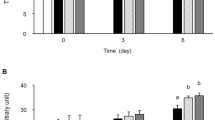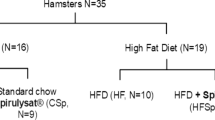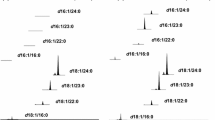Abstract
Sphingolipids are constituents of cellular membranes and play important roles as second messengers mediating cell functions. As significant components in foods, sphingolipids have been proven to be critical for human health. Moreover, diverse metabolic intermediates of sphingolipids are known to play key roles both in proinflammatory and in anti-inflammatory effects. However, the effect of dietary sphingolipids on inflammation is a complicated field that needs to be further assessed. Our study evaluated the effects of orally administered maize glucosylceramide (GluCer), one of the most conventional dietary sphingolipids, on inflammation using the 2,4-dinitro-1-fluorobenzene-treated BALB/c murine model. Oral administration of GluCer inhibited ear swelling and leukocyte infiltration to the inflammatory site, suggesting that dietary GluCer has anti-inflammatory properties. ELISA analyses revealed that oral administration of GluCer for 6 days had not modified the Th1/Th2 balance, but significantly down-regulated the activation of TNF-α at the inflammatory site. Based on these results, the down-regulation of TNF-α by dietary GluCer may suppress vascular permeability and reduce the migration of inflammatory cells. Our findings increase understanding of the actions of dietary sphingolipids on the balance of the immune response.



Similar content being viewed by others
Abbreviations
- DNFB:
-
2,4-Dinitro-1-fluorobenzene
- GluCer:
-
Glucosylceramide
- IFN-γ:
-
Interferon-gamma
- IgE:
-
Immunoglobulin E
- IL-1β:
-
Interleukin-1beta
- IL-4:
-
Interleukin-4
- IL-6:
-
Interleukin-6
- NF-κB:
-
Receptor activator of nuclear factor-kappa B
- Th1:
-
T-helper 1
- Th2:
-
T-helper 2
- TNF-α:
-
Tumor necrosis factor-alpha
References
Lingwood D, Simons K (2010) Lipid rafts as a membrane-organizing principle. Science 327:46–50
Bartke N, Hannun YA (2009) Bioactive sphingolipids: metabolism and function. J Lipid Res 50:91–96
Prabuddha S, Barbara B, David H (2007) Lipid rafts, fluid/fluid phase separation, and their relevance to plasma membrane structure and function. Semin Cell Dev Biol 18:583–590
Merrill AH Jr, Schmelz EM, Dillehay DL, Spiegel S, Shayman JA, Schroeder JJ, Riley RT, Voss KA, Wang E (1997) Sphingolipids—the enigmatic lipid class: biochemistry, physiology, and pathophysiology. Toxicol Appl Pharmacol 142:208–225
Spiegel S, Merrill AH Jr (1996) Sphingolipid metabolism and cell growth regulation. FASEB J 10:1388–1397
Zheng W, Kollmeyer J, Symolon H, Momin A, Munter E, Wang E, Kelly S, Allegood JC, Liu Y, Peng Q, Ramaraju H, Sullards MC, Cabot M, Merrill AH Jr (2006) Ceramides and other bioactive sphingolipid backbones in health and disease: lipidomic analysis, metabolism and roles in membrane structure, dynamics, signaling and autophagy. Biochim Biophys Acta 1758:1864–1884
Nixon GF (2009) Sphingolipids in inflammation: pathological implications and potential therapeutic targets. Br J Pharmacol 158:982–993
El Alwani M, Wu BX, Obeid LM, Hannun YA (2006) Bioactive sphingolipids in the modulation of the inflammatory response. Pharmacol Ther 112:171–183
Sugawara T, Tsuduki T, Yano S, Hirose M, Duan J, Aida K, Ikeda I, Hirata T (2010) Intestinal absorption of dietary maize glucosylceramide in lymphatic duct cannulated rats. J Lipid Res 51:1761–1769
Yunoki K, Ogawa T, Ono J, Miyashita R, Aida K, Oda Y, Ohnishi M (2008) Analysis of sphingolipid classes and their contents in meals. Biosci Biotechnol Biochem 72:222–225
Duan J, Sugawara T, Hirata T (2010) Sphingolipids in seafood using HPLC with evaporative light-scattering detection: its application in tissue distribution of sphingolipids in fish. J Oleo Sci 59:509–513
Sugawara T, Miyazawa T (1999) Separation and determination of glycolipids from edible plant sources by high performance liquid chromatography and evaporative light scattering detection. Lipids 34:1231–1237
Nyberg L, Duan RD, Nilsson Å (1998) Sphingomyelin—a dietary component with structural and biological function. Prog Colloid Polym Sci 108:119–128
Vesper H, Schmelz EM, Nikolova-Karakashian MN, Dillehay DL, Lynch DV, Merrill AH Jr (1999) Sphingolipids in food and the emerging importance of sphingolipids to nutrition. J Nutr 129:1239–1250
Duivenvoorden I, Voshol PJ, Rensen PC, van Duyvenvoorde W, Romijn JA, Emeis JJ, Havekes LM, Nieuwenhuizen WF (2006) Dietary sphingolipids lower plasma cholesterol and triacylglycerol and prevent liver steatosis in APOE*3Leiden mice. Am J Clin Nutr 84:312–321
Tsuji K, Mitsutake S, Ishikawa J, Takagi Y, Akiyama M, Shimizu H, Tomiyama T, Igarashi Y (2006) Dietary glucosylceramide improves skin barrier function in hairless mice. J Dermatol Sci 44:101–107
Kinoshita M, Hori N, Aida K, Sugawara T, Ohnishi M (2007) Prevention of melanin formation by yeast cerebroside in B16 mouse melanoma cells. J Oleo Sci 56:645–648
Oshida K, Shimizu T, Takase M, Tamura Y, Shimizu T, Yamashiro Y (2003) Effects of dietary sphingomyelin on central nervous system myelination in developing rats. Pediatr Res 53:589–593
Schmelz EM (2000) Dietary sphingomyelin and other sphingolipids in health and disease. Nutr Bull 25:135–139
Duan RD, Nilsson Å (2009) Metabolism of sphingolipids in the gut and its relation to inflammation and cancer development. Prog Lipid Res 48:62–72
Merrill AH Jr, Schmelz EM, Wang E, Schroeder JJ, Dillehay DL, Riley RT (1995) Role of dietary sphingolipids and inhibitors of sphingolipid metabolism in cancer and other diseases. J Nutr 125:1677–1682
Aida K, Kinoshita M, Tanji M, Sugawara T, Tamura M, Ono J, Ueno N, Ohnishi M (2005) Prevention of aberrant crypt foci formation by dietary maize and yeast cerebrosides in 1,2-dimethylhydrazine-treated mice. J Oleo Sci 54:45–49
Berra B, Colombo I, Sottocornola E, Giacosa A (2002) Dietary sphingolipids in colorectal cancer prevention. Eur J Cancer Prev 11:193–197
Sugawara T, Kinoshita M, Ohnishi M, Miyazawa T (2002) Apoptosis induction by wheat-flour sphingoid bases in DLD-1 human colon cancer cells. Biosci Biotechnol Biochem 66:2228–2231
Kinoshita M, Aida K, Tokuji Y, Sugawara T, Ohnishi M (2009) Effects of dietary plant cerebroside on gene expression in the large intestine of 1,2-dimethylhydrazine (DMH)-treated mice determined by DNA microarray analysis. J Food Lipids 16:200–208
Kidd P (2003) Th1/Th2 balance: the hypothesis, its limitations, and implications for health and disease. Altern Med Rev 8:223–246
Hernández-Pando R, Orozcoe H, Sampieri A, Pavón L, Velasquillo C, Larriva-Sahd J, Alcocer JM, Madrid MV (1996) Correlation between the kinetics of Th1, Th2 cells and pathology in a murine model of experimental pulmonary tuberculosis. Immunology 89:26–33
Dinarello CA (1997) Proinflammatory and anti-inflammatory cytokines as mediators in the pathogenesis of septic shock. Chest 112:321–329
Lahiri S, Futerman AH (2007) The metabolism and function of sphingolipids and glycosphingolipids. Cell Mol Life Sci 64:2270–2284
Yopp AC, Randolph GJ, Bromberg JS (2003) Leukotrienes, sphingolipids, and leukocyte trafficking. J Immunol 171:5–10
Melendez AJ, Khaw AK (2002) Dichotomy of Ca2+ signals triggered by different phospholipid pathways in antigen stimulation of human mast cells. J Biol Chem 277:17255–17262
Jolly PS, Bektas M, Olivera A, Gonzalez-Espinosa C, Proia RL, Rivera J, Milstien S, Spiegel S (2004) Transactivation of sphingosine-1-phosphate receptors by FcepsilonRI triggering is required for normal mast cell degranulation and chemotaxis. J Exp Med 199:959–970
Snider AJ, Orr Gandy KA, Obeid LM (2010) Sphingosine kinase: role in regulation of bioactive sphingolipid mediators in inflammation. Biochimie 92:707–715
Gilfillan AM, Tkaczyk C (2006) Integrated signalling pathways for mast-cell activation. Nat Rev Immunol 6:218–230
Allende ML, Dreier JL, Mandala S, Proia RL (2004) Expression of the sphingosine 1-phosphate receptor, S1P1, on T-cells controls thymic emigration. J Biol Chem 279:15396–15401
Wei SH, Rosen H, Matheu MP, Sanna MG, Wang SK, Jo E, Wong CH, Parker I, Cahalan MD (2005) Sphingosine 1-phosphate type 1 receptor agonism inhibits transendothelial migration of medullary T cells to lymphatic sinuses. Nat Immunol 6:1228–1235
Olivera A, Rivera J (2005) Sphingolipids and the balancing of immune cell function: lessons from the mast cell. J Immunol 174:1153–1158
Sakai S, Sugawara T, Kishi T, Yanagimoto K, Hirata T (2010) Effect of glucosamine and related compounds on the degranulation of mast cells and ear swelling induced by dinitrofluorobenzene in mice. Life Sci 86:337–343
Tomobe YI, Morizawa K, Tsuchida M, Hibino H, Nakano Y, Tanaka Y (2000) Dietary docosahexaenoic acid suppresses inflammation and immune responses in contact hypersensitivity reaction in mice. Lipids 35:61–69
Nilsson Å (1968) Metabolism of sphingomyelin in the intestinal tract of the rat. Biochim Biophys Acta 164:575–584
Sugawara T, Kinoshita M, Ohnishi M, Nagata J, Saito M (2003) Digestion of maize sphingolipids in rats and uptake of sphingadienine by Caco-2 cells. J Nutr 133:2777–2782
Ono J, Kinoshita M, Aida K, Tamura M, Ohnishi M (2010) Effects of dietary glucosylceramide on dermatitis in atopic dermatitis model mice. Eur J Lipid Sci Tech 112:708–711
Oskeritzian CA, Milstien S, Spiegel S (2007) Sphingosine-1-phosphate in allergic responses, asthma and anaphylaxis. Pharmacol Ther 115:390–399
Ma Y, Pitson S, Hercus T, Murphy J, Lopez A, Woodcock J (2005) Sphingosine activates protein kinase A type II by a novel cAMP-independent mechanism. J Biol Chem 280:26011–26017
Spiegel S, Milstien S (2003) Sphingosine-1-phosphate: an enigmatic signalling lipid. Nat Rev Mol Cell Biol 4:397–407
Pettus BJ, Kitatani K, Chalfant CE, Taha TA, Kawamori T, Bielawski J, Obeid LM, Hannun YA (2005) The coordination of prostaglandin E2 production by sphingosine-1-phosphate and ceramide-1-phosphate. Mol Pharmacol 68:330–335
Aggarwal BB (2003) Signalling pathways of the TNF superfamily: a double-edged sword. Nat Rev Immunol 3:745–756
Tartaglia LA, Goeddel DV (1992) Two TNF receptors. Immunol Today 13:151–153
Oppenheim JJ (2001) Cytokines: past, present, and future. Int J Hematol 74:3–8
Borish LC, Steinke JW (2003) Cytokines and chemokines. J Allergy Clin Immunol 111:460–475
Snider AJ, Orr Gandy KA, Obeid LM (2010) Sphingosine kinase: role in regulation of bioactive sphingolipid mediators in inflammation. Biochimie 92:707–715
Cruz MT, Duarte CB, Gonçalo M, Figueiredo A, Carvalho AP, Lopes MC (2002) Differential activation of nuclear factor kappa B subunits in a skin dendritic cell line in response to the strong sensitizer 2,4-dinitrofluorobenzene. Arch Dermatol Res 294:419–425
Ryu KR, Lee B, Lee IA, Oh S, Kim DH (2010) Anti-scratching behavioral effects of N-stearoyl-phytosphingosine and 4-hydroxysphinganine in mice. Lipids 45:613–618
Inoue R, Otsuka M, Nishio A, Ushida K (2007) Primary administration of Lactobacillus johnsonii NCC533 in weaning period suppresses the elevation of proinflammatory cytokines and CD86 gene expressions in skin lesions in NC/Nga mice. FEMS Immunol Med Microbiol 50:67–76
Fujiwara R, Sasajima N, Takemura N, Ozawa K, Nagasaka Y, Okubo T, Sahasakul Y, Watanabe J, Sonoyama K (2010) 2,4-Dinitrofluorobenzene-induced contact hypersensitivity response in NC/Nga mice fed fructo-oligosaccharide. J Nutr Sci Vitaminol 56:260–265
Wang M, Qin X, Mudgett JS, Ferguson TA, Senior RM, Welgus HG (1999) Matrix metalloproteinase deficiencies affect contact hypersensitivity: stromelysin-1 deficiency prevents the response and gelatinase B deficiency prolongs the response. PANS 96:6885–6889
Snider AJ, Orr Gandy KA, Obeid LM (2010) Sphingosine kinase: role in regulation of bioactive sphingolipid mediators in inflammation. Biochimie 92:707–715
Ishikawa J, Takada S, Hashizume K, Takagi Y, Hotta M, Masukawa Y, Kitahara T, Mizutani Y, Igarashi Y (2009) Dietary glucosylceramide is absorbed into the lymph and increases levels of epidermal sphingolipids. J Dermatol Sci 56:220–222
Proksch E, Fölster-Holst R, Jensen JM (2006) Skin barrier function, epidermal proliferation and differentiation in eczema. J Dermatol Sci 43:159–169
Piekutowska A, Pin D, Rème CA, Gatto H, Haftek M (2008) Effects of a topically applied preparation of epidermal lipids on the stratum corneum barrier of atopic dogs. J Comp Pathol 138:197–203
Acknowledgments
This work was supported by the Program for Promotion of Basic and Applied Researches for Innovations in Bio-oriented Industry (BRAIN).
Author information
Authors and Affiliations
Corresponding author
About this article
Cite this article
Duan, J., Sugawara, T., Sakai, S. et al. Oral Glucosylceramide Reduces 2,4-Dinitrofluorobenzene Induced Inflammatory Response in Mice by Reducing TNF-Alpha Levels and Leukocyte Infiltration. Lipids 46, 505–512 (2011). https://doi.org/10.1007/s11745-010-3518-9
Received:
Accepted:
Published:
Issue Date:
DOI: https://doi.org/10.1007/s11745-010-3518-9




